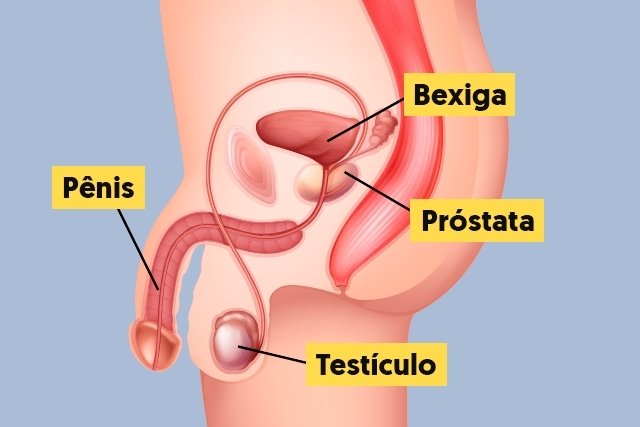The prostate is a gland in the male genital system that is located between the bladder and the urethra and is between 4 and 6 cm, similar to a walnut.
This gland begins to develop during adolescence, due to the action of testosterone, and grows until it reaches its average size, which is approximately 3 to 4 cm at the base, 4 to 6 cm in the cephalo-caudal part, and 2 to 3 cm in the anteroposterior part.
There are several diseases related to the prostate and they can appear at any stage of life, however they are more common after the age of 50, the main ones being prostatitis, benign prostatic hyperplasia or cancer. Therefore, it is important to have regular exams from the age of 45/50 to identify prostate problems early and achieve a cure. Check out the 6 exams that help evaluate the prostate.

Where is the prostate located?
The prostate is located between the man’s bladder and urethra, being in front of the rectum, which is the final portion of the intestine, and, therefore, it is possible to feel the prostate through a digital rectal exam, carried out by the doctor.
What is the prostate for?
The function of the prostate in the body is to produce part of the liquid that forms sperm, helping to feed and protect sperm.
What are the most common prostate diseases?
The main changes in the prostate are cancer, benign prostate hyperplasia and prostatitis and can be caused by genetic inheritance, hormonal changes or viral or bacterial infections.
1. Prostate cancer
Prostate cancer is more common in men over 50 years of age, but it can also appear earlier, especially when there is a family history of this disease.
Prostate cancer treatment is done through surgery to remove the entire prostate. Other forms of treatment that can be used as an option to surgery and in some cases after surgery are radiotherapy and treatment with hormones to shrink the tumor and reduce the risk of the disease progressing.
2. Benign prostate hyperplasia
Benign prostatic hyperplasia, also known as enlarged prostate, is an increase in the size of the prostate, but without the presence of cancer. This is the most common change in the prostate because it is normal for the prostate to enlarge naturally as we age, which can cause some symptoms.
Treatment for benign prostatic hyperplasia can be done through medication to relax the prostate muscle, hormones to reduce the size of the organ or surgery to remove the “core” of the prostate.
3. Prostatitis
Prostatitis is an infection in the prostate, usually caused by viruses or bacteria, and can also arise as a result of a poorly treated urinary infection. This change can also generate “swelling” of this gland.
Prostatitis is treated through the use of antibiotics and medications to reduce pain, but in some cases hospitalization may be necessary to treat the disease with intravenous medication.
What are the signs of prostate problems?
The signs and symptoms of prostate problems are similar. Therefore, if the patient presents any urinary symptoms, it is important to seek out a trusted urologist. If you believe you may have a change in your prostate, select what you are feeling and find out your risk:
The symptom test is only a guidance tool and does not serve as a diagnosis or replace a consultation with a urologist.
How do you know if your prostate is healthy?
To know if the prostate is healthy, you need to do tests such as:
- Rectal examination: is the palpation of the prostate through the patient’s anus, being used to evaluate the size, consistency/hardness of the prostate and the presence or absence of nodules;
- PSA: is a blood test that counts the amount of this prostate-specific protein, and results with high values mean that the prostate is enlarged, which could be benign prostatic hyperplasia, prostatitis or cancer;
- Biopsy: examination where a small piece of the prostate is removed to be evaluated in the laboratory, to evaluate the characteristics of the cells in order to investigate the possibility of prostate cancer;
- Urine analysis: used to detect the presence of bacteria in urine and diagnose cases of prostatitis.
These tests should be done at any age in the presence of symptoms of changes in the prostate and in accordance with the urologist’s instructions. However, it is important to perform the touch and PSA test once a year after the age of 50 or after the age of 45, in cases of family history of prostate cancer and in black people, and it is important to remember that prostate cancer There is a high chance of a cure when identified early on.

Sign up for our newsletter and stay up to date with exclusive news
that can transform your routine!
Warning: Undefined array key "title" in /home/storelat/public_html/wp-content/plugins/link-whisper-premium/templates/frontend/related-posts.php on line 12
Warning: Undefined array key "title_tag" in /home/storelat/public_html/wp-content/plugins/link-whisper-premium/templates/frontend/related-posts.php on line 13



